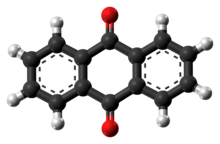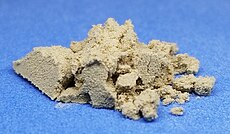Anthraquinone, also called anthracenedioneordioxoanthracene, is an aromatic organic compound with formula C
14H
8O
2. Several isomers exist but these terms usually refer to 9,10-anthraquinone (IUPAC: 9,10-dioxoanthracene) wherein the keto groups are located on the central ring. It is used as a digester additive to wood pulp for papermaking. Many anthraquinone derivatives are generated by organisms or synthesised industrially for use as dyes, pharmaceuticals, and catalysts. Anthraquinone is a yellow, highly crystalline solid, poorly solubleinwater but soluble in hot organic solvents. It is almost completely insoluble in ethanol near room temperature but 2.25 g will dissolve in 100 g of boiling ethanol. It is found in nature as the rare mineral hoelite.

| |

| |

| |
| Names | |
|---|---|
| Preferred IUPAC name
Anthracene-9,10-dione[2] | |
Other names
| |
| Identifiers | |
| |
3D model (JSmol) |
|
| 390030 | |
| ChEBI | |
| ChEMBL | |
| ChemSpider |
|
| ECHA InfoCard | 100.001.408 |
| 102870 | |
| KEGG |
|
PubChem CID |
|
| RTECS number |
|
| UNII | |
| UN number | 3143 |
CompTox Dashboard (EPA) |
|
| |
| |
| Properties | |
| C14H8O2 | |
| Molar mass | 208.216 g·mol−1 |
| Appearance | Yellow solid |
| Density | 1.438 g/cm3[1] |
| Melting point | 284.8 °C (544.6 °F; 558.0 K)[1] |
| Boiling point | 377 °C (711 °F; 650 K)[1] |
| Insoluble | |
| Hazards | |
| Occupational safety and health (OHS/OSH): | |
Main hazards |
possible carcinogen |
| GHS labelling: | |

| |
| Danger | |
| H350 | |
| P201, P202, P281, P308+P313, P405, P501 | |
| Flash point | 185 °C (365 °F; 458 K) |
| Related compounds | |
Related compounds |
quinone, anthracene |
Except where otherwise noted, data are given for materials in their standard state (at 25 °C [77 °F], 100 kPa). | |
There are several current industrial methods to produce 9,10-anthraquinone:
It also arises via the Rickert–Alder reaction, a retro-Diels–Alder reaction.
Hydrogenation gives dihydroanthraquinone (anthrahydroquinone). Reduction with copper gives anthrone.[4] Sulfonation with sulfuric acid gives anthroquinone-1-sulfonic acid,[5] which reacts with sodium chlorate to give 1-chloroanthaquinone.[6]
9,10-Anthraquinone is used as a digester additive in production of paper pulpbyalkaline processes, like the kraft, the alkaline sulfite or the Soda-AQ processes. The anthraquinone is a redox catalyst. The reaction mechanism may involve single electron transfer (SET).[7] The anthraquinone oxidizes the reducing end of polysaccharides in the pulp, i.e., cellulose and hemicellulose, and thereby protecting it from alkaline degradation (peeling). The anthraquinone is reduced to 9,10-dihydroxyanthracene which then can react with lignin. The lignin is degraded and becomes more watersoluble and thereby more easy to wash away from the pulp, while the anthraquinone is regenerated. This process gives an increase in yield of pulp, typically 1–3% and a reduction in kappa number.[8]
9,10-anthraquinone is used as a bird repellant on seeds, and as a gas generator in satellite balloons.[9] It has also been mixed with lanolin and used as a wool spray to protect sheep flocks against kea attacks in New Zealand.[10]
Several other isomers of anthraquinone exist, including the 1,2-, 1,4-, and 2,6-anthraquinones. They are of minor importance compared to 9,10-anthraquinone.
Anthraquinone has no recorded LD50, probably because it is so insoluble in water.
In terms of metabolism of substituted anthraquinones, the enzyme encoded by the gene UGT1A8 has glucuronidase activity with many substrates including anthraquinones.[11]